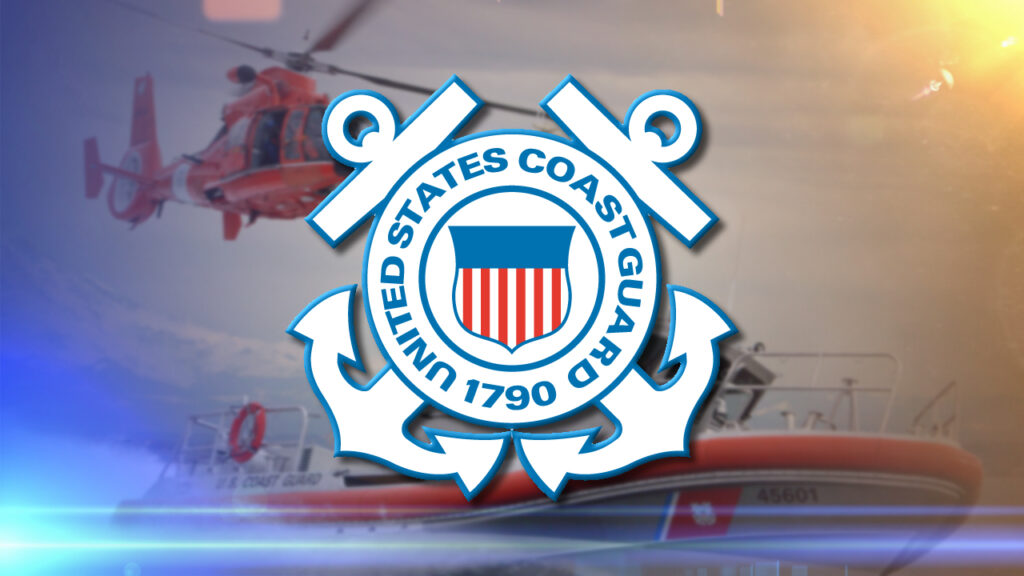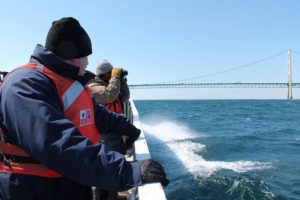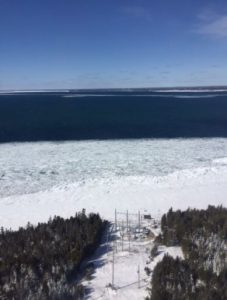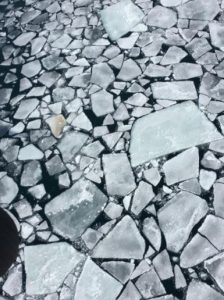UPDATE: U.S. Coast Guard and other agencies respond to spill in Straits of Mackinac

UPDATE: Wednesday, April 25th
The Unified Command completed the underwater remotely operated vehicle visual assessment of American Transmission Company’s six utility cables, Monday.

The ROV obtained underwater, visual imagery showing that two of six cables were severed.
With the sonar scan and visual assessment complete, ATC, Durocher Marine, and T&T Subsea are developing a plan to effectively cap the ends of the severed cables, to prevent any potential pollution. After approval of the plan by the Unified Command, the capping operation will begin later this week.
Under the oversight of the Unified Command, American Transmission Company continues to extract mineral oil from two damaged cables in the Straits of Mackinac. To date, approximately 590 gallons of mineral oil has been extracted from the two cables.
UPDATE: Monday, April 23rd 9:00 a.m.
On Sunday, the American Transmission Company deployed a remotely operated underwater vehicle (ROV) to better assess damage to the affected ATC utility cables.

ATC contracted with Durocher Marine and T&T Subsea to provide tugs, a barge, and an ROV to assess the damage to the utility cables. The ROV will obtain underwater, visual imagery of the cables, and the images obtained will provide the Unified Command with the information needed to determine how best to deal with the damaged cables.
Under the oversight of the Unified Command, the American Transmission Company continues to extract mineral oil from two damaged cables in the Straits of Mackinac.
UPDATE: Monday, April 16th 9:30 a.m.
The Unified Command has announced that the American Transmission Company will deploy sonar scanning technology and a remotely operated underwater vehicle (ROV) to better asses the damage done to the affected cables. The ROV and the sonar technology is slated to be used this week, as soon as weather conditions no longer pose a danger to responders.

Credit: U.S. Coast Guard District 9
Durocher Marine and T&T Subsea were contracted to provide tugs, a barge and an ROV to assess the damage. A tug retrofitted with sonar side-scanning technology will locate the damage in the utility cables.
The ROV will obtain underwater, visual imagery of the cables. These images will provide the Unified Command with the information needed to determine how to best deal with the damaged cables.
Throughout the weekend, responders worked shoreside and continued mineral oil extraction operations. To date, more than 300 gallons of mineral oil has been extracted from the utility cables.
Wildlife professionals from the United States Department of Agriculture’s Animal and Plant Health Inspection Service (USDA-APHIS) Wildlife Services program conducted wildlife surveillance from land and did not observe any impacted birds or wildlife.
When weather conditions no longer pose a danger to responders, USDA-APHIS wildlife professionals, MI DEQ environmental experts, and Coast Guard marine science technicians will resume efforts to survey the area from vessels and airplanes to identify any impacts to the environment. No impacts have been identified so far.
The Coast Guard’s investigation into the vessel activity that may have contributed to damage to the ATC cables and the three dents in the Enbridge pipelines is ongoing.
The Unified Command encourages the public to report any sightings of pollution or affected wildlife. To report affected wildlife or animals acting abnormally please call the USDA at (517)-336-1928. To report any oil sheen or pollution, please call the National Response Center at 1-800-424-8802.
UPDATE: Wednesday, April 11th 3:00 p.m.
The Unified Command has been notified by Enbridge officials that further structural analysis conducted by Enbridge indicates that small dents exist in their pipeline infrastructure.
Enbridge has notified the Unified Command that the damage poses no threat to the overall integrity of their infrastructure.
The mineral oil leak from the American Transmission Company’s utility cables may have been caused by vessel activity and is still under investigation.
Coast Guard Marine Science Technicians and Environmental Quality Analysts from Michigan’s Department of Environmental Quality have conducted daily surface surveys by boat and have not observed signs of pollution. Coast Guard Marine Science Technicians have also been present on overflights and have not seen any signs of an oil sheen.
The Unified Command is planning to deploy thermal scanning technology as well as a Remotely Operated Underwater Vehicle (ROV) to better assess the damage to the affected utility lines while efforts continue to extract the remaining product from two cables.
A commercial tug and barge are being outfitted to deploy the ROV equipment this weekend. Information from the thermal scans, as well as from the ROV will help inform the Unified Command’s salvage operations plan for the affected utility cables. The Unified Command is monitoring incoming weather patterns, which may impact future operations. Wind and wave height will be the primary factors that will determine if salvage operations can safely continue over the weekend.
American Transmission Company, a transmission-only electric utility, contracted North Shore Environmental to remove product from the cables. From a shore-side facility, North Shore Environmental is vacuuming the mineral oil from a less than one inch diameter void in the cables that stretch three and a half miles across the Straits of Mackinac.
To date, more than 250 gallons of the mineral oil have been extracted from one of the utility cables. Work to remove product from the second damaged cable commenced yesterday.
Wildlife biologists from the United States Department of Agriculture’s Animal and Plant Health Inspection Service (USDA-APHIS) Wildlife Services program, Michigan Department of Natural Resources, and personnel from the Michigan Department of Environmental Quality are surveying the area, on the water and from the shore and air, to look for any signs of pollution or impacted fish and wildlife. No impacts to the environment or wildlife have been identified.
“We are looking for any indications that birds or any other wildlife have come into contact with oil,” said a wildlife specialist with USDA-APHIS. “We encourage individuals who know of affected wildlife to report any sightings.”
The personnel surveying the area are trained to identify impacts on wildlife. More than 3,000 waterfowl, including Long-tailed ducks, Common Mergansers, Herring Gulls, Goldeneye, and eagles, have been observed over the course of the response from areas near Mackinac, Round and Boise Blanc Islands as well as on the shoreline near Mackinaw City, and west of the Mackinac Bridge. Personnel on scene have observed no abnormal bird behavior in the affected area.
The mineral oil in the cables acts as an insulator to ensure the integrity of the electricity within the cable.
All entities responsible for active utility lines that cross the Straits were notified by the Unified Command to ensure that all steps are taken to assess and mitigate any further damage to infrastructure or risk to public health and the environment. The utilities are continuing to conduct assessments of their infrastructure.
UPDATE: Monday, April 9th 2:00 p.m.
Today, the Unified Command continues to oversee response efforts. The Command is made up of the U.S. Coast Guard, Michigan Department of Environmental Quality, county emergency managers, local tribes, the National Oceanographic and Atmospheric Administration, U.S. Fish and Wildlife, Environmental Protection Agency and American Transmission Company.
North Shore Environmental was called to extract remaining product from the two cables. The company is vacuuming the mineral oil from a shoreside facility through a less than one-inch diameter void in the cables that stretch about three and a half miles across the Straits of Mackinac.
To date, approximately 250 gallons of mineral oil has been extracted from one of the utility cables. Work to remove product from the second damaged cable will commence when the first one is complete.
Each cable can hold up to 400 gallons. Product in each cable was secured Tuesday, April 3rd, and there is no evidence of any ongoing release. The estimated spill of mineral oil from the leak is 600 gallons.
The mineral oil in the cables acts as an insulator to ensure the integrity of the electricity within the cable.
A Coast Guard marine science technician and an environmental quality analyst for Michigan’s Department of Environmental Quality transited the Straights of Mackinac by boat on Saturday and Sunday and observed no signs of pollution. Another Coast Guard marine science technician was present onboard an overflight on Saturday and Sunday and saw no signs of a sheen.
The United States Department of Agriculture’s Animal and Plant Health Inspection Service, Michigan Department of Environmental Quality, and a Michigan Department of Natural Resources wildlife biologist also surveyed the area on the water and from the shore to look for any signs of pollution or impacted fish and wildlife. No impacts to the environment or wildlife have been identified.
“During the weekend, we surveyed the areas near Mackinac, Round, and Boise Blanc Islands. We then surveyed near the shoreline of Mackinaw City and went west of the bridge,” said Anthony Wilson, wildlife specialist with the USDA Animal and Plant Health Inspection Service (APHIS, Wildlife Services), in a press release. “We did not see any oil sheen or injured wildlife. We observed more than 1,200 water fowl including long-tailed ducks, common mergansers, herring gulls, common loon and even a bald eagle.”
“Our top priorities remain protecting public health, the safety of the communities in the region and responders, and to limit the environmental impacts from the product that was discharged,” said Coast Guard Capt. Marko Broz, the Federal On-Scene Coordinator for the response. “I am very pleased with the partnership thus far between the federal, state, tribal, and local agencies to ensure the safe extraction of the remaining mineral oil in the two cables and to identify any signs of pollution or negative impact to the environment and wildlife. Moving forward, our focus remains on the effective extraction of the oil from the two cables, protecting wildlife, and identifying any further damage to infrastructure in the Straits.”
The mineral oil leak from ATC’s utility cables remains under investigation. All entities responsible for active utility lines that cross the Straits have been notified by the Unified Command to ensure that all steps are taken to assess and mitigate any further damage to infrastructure or risk to public health and the environment. There have been no further indications of damage or possible pollution. However, the utilities are continuing to conduct assessments of their infrastructure.
The U.S. Coast Guard is designated as the lead federal agency for directing and overseeing removal and cleanup efforts by the responsible party in the coastal zone.
UPDATE: Monday, April 9th 9:00 a.m.
The Unified Command is working with several other federal, state, and local agencies to continue to oversee the response to the mineral oil spill from two utility cables in the Straits of Mackinac, as announced over the weekend.
An oil spill response organization, contracted by the American Transmission Company, has extracted approximately 50 percent of the mineral oil out of one of the utility cables that cross the Straits of Mackinac. There are ongoing efforts to vacuum mineral oil from the two affected cables, and there is still no evidence of an ongoing release.
From a shore side facility, the OSRO is successfully vacuuming the mineral oil from a less than one-inch void in the cables that stretch three and a half miles across the Straits of Mackinac.
Members of the United States Department of Agriculture Animal Plant Health Inspection Service, Michigan Department of Environmental Quality, a Michigan Department of Natural Resources wildlife biologist, Coast Guard personnel, and a tribal representative are surveying the area via airplane, vessel, and shore to identify any signs of pollution or impacted fish and wildlife. No impacts to the environment have been identified.
The cause of the leak is still under investigation, and it is still a possibility that the leak may have been caused by vessel activity in the Straits. All entities responsible for active utility lines that cross the Straits have been notified by the Unified Command to ensure that all steps are taken to assess and mitigate any further damage to infrastructure or risk to public health and the environment.
There have been no further indications of damage or possible pollution. However, the utility companies are continuing to conduct assessments of their infrastructure.
The National Contingency Plan designates the U.S. Coast Guard as the lead federal agency for directing and overseeing removal and cleanup efforts by the responsible party.
UPDATE: Friday, April 6th 4:00 p.m.
The mineral oil leak in American Transmission Company’s utility lines may have been caused by vessel activity in the Straits of Mackinac; in addition to the ongoing environmental response, the Coast Guard initiated a marine casualty investigation on Friday.
The Unified Command initiated notifications to entities responsible for other lines that cross the Straits to ensure that all steps are taken to assess and mitigate any potential damage to infrastructure or risk to the public health and the environment. Currently, there are no new indications of possible pollution.
The Coast Guard and ATC will continue to conduct overflights throughout the week as well as surveying the water from vessels. No oil sheen or indications of pollution are present.
The Unified Command’s effort to extract oil from ATC’s utility lines is ongoing. The estimated mineral oil spill from ATC’s utility lines remains at 600 gallons.
UPDATE: Friday, April 6th 8:45 a.m.
A Coast Guard marine science technician and an environmental quality analyst for Michigan’s Department of Environmental Quality surveyed the Straits of Mackinac onboard a vessel. The responders did not identify any mineral oil sheens, signs of pollution or adverse impacts to the environment or wildlife.

Members of the U.S. Department of Agriculture are deploying to the scene to survey the area for any wildlife that may be affected by the mineral oil spill.
The National Oceanic and Atmospheric Administration’s new calculation for the trajectory of the spill is to the east and northeast of the utility line, due to changing weather conditions. The entities responsible for the operation of the water intakes in the surrounding communities have been notified of the change in trajectory, however there is still low risk to drinking water and the environment due to the product’s low toxicity and dilution in the waterway.
The mineral oil is not known to be leaking from the source at this time, and the estimated amount of oil spilled remains at 600 gallons.
In the mineral oil, there is a dielectric fluid that contains a benzene compound.
“The benzene molecule is known to cause cancer but these larger chemicals (benzene compounds in the dielectric fluid) have not been classified as causing cancer,” said Edward Primeau, an industrial hygienist from the Coast Guard Atlantic Strike Team, in a press release.
Crews continue to extract the oil from the affected two utility lines.
UPDATE: Thursday, April 5th 2:00 p.m.
The Unified Command, made up of the U.S. Coast Guard, Michigan Department of Environmental Quality, county emergency managers, local tribes, the National Oceanographic and Atmospheric Administration, U.S. Fish and Wildlife, Environmental Protection Agency and American Transmission Company, has isolated the impacted utility lines and is monitoring the removal progress of the remaining mineral oil from those lines Thursday, according to a press release.

The Oil Spill Response Organization, contracted by the American Transmission Company, removed approximately 10 percent of the mineral oil from one of the utility lines on Wednesday. The Unified Command will continue to consult with oil recovery experts and engineers today to ensure the oil extraction process is effective.
Approximately 400 gallons of oil remains in each utility line and is not known to be leaking from the source. It is still estimated that 600 gallons of mineral oil leaked from the utility lines before securing the source.
The Coast Guard deployed an MH-60 Jayhawk crew from Coast Guard Air Station Traverse City on Monday and Wednesday afternoon to search for pollution over the Straits of Mackinac. The flight crews used infra-red technology to detect temperature differences between the oil and water and did not locate any oil sheen or signs of pollution. Coast Guard overflights will continue to monitor the spill.
In consultation with engineers from the Pipeline and Hazardous Materials Safety Administration and the Michigan Department of Environmental Quality, a 10-person work crew and vacuum truck are on site for the OSRO working to draw the oil out of the two decommissioned utility lines; no pressure is being applied to the lines. A suction, or negative pressure, is present on the entire span of the lines across the Straits.
The calculated trajectory of the spilled mineral oil is to the south and southwest of the source. Threat to the public, fisheries and wildlife remains low, given the inaccessibility of the shorelines from ice, the dilution of the product and the mobility of fish.
A concern remains that waterfowl or shore birds may come in contact with the product floating on the surface. The Unified Command is exploring methods to deter birds from the area.
MACKINAW CITY — The U.S. Coast Guard, along with local, state and federal partners, are working with the American Transmission Company to respond to a leak from a utility line in the Straits of Mackinac, approximately two miles west of the Mackinac Bridge.

According to a press release, the Coast Guard received notification that an electrical line cased with mineral oil might be leaking into the Straits of Mackinac Monday afternoon. Upon notification, Coast Guard crews traveled to the area to investigate, and a Coast Guard helicopter crew conducted an overflight but neither detected an oil sheen.
The utility line’s owner, the American Transmission Company, determined that there is a leak in the utility line that crosses the Straits of Mackinac. The cables contain a thin, light mineral–based fluid for insulation. The line is currently inoperable.
There is no impact to power supply to the local communities. The cause of the leak is currently under investigation.
The Coast Guard established the Unified Command, comprised of Michigan Department of Environmental Quality, county emergency managers, local tribes, the National Oceanographic and Atmospheric Administration, U.S. Fish and Wildlife, Environmental Protection Agency and the responsible party to oversee the pollution response and mitigate any risks to the environment.
Initial reports indicate that approximately 600 gallons of product has been released into the straits. The maximum potential for the spill is more than 4,000 gallons. There have been no reported impacts to wildlife, and responders will continue to assess as work progresses.
ATC has activated their Oil Spill Response Plan and there is currently no pressure on the affected lines. According to the press release, the oil is not known to be leaking from the source. ATC will remove the oil from the lines via vacuum as well as conduct overflights to monitor the spill.
Samples of the product have been sent for laboratory analysis. Given the dilution of the product and mobility of fish, there is a low risk to fisheries and wildlife. The greatest threat is to waterfowl or shore birds that may come in contact with the product floating on the surface.
Due to the inaccessibility of the shorelines from ice, there is a low-risk threat to the public since they are unable to come in contact with the oil. The dilution of the oil and distance from the bridge provide additional protection from the product.
There are two water intakes in the general vicinity, but given the dilution of the oil and the distance of the intakes from the source of the discharge, there is no significant threat to drinking water at this time.
Commercial vessel traffic has not been impacted.
“Our top priorities are to protect public health, the safety of both responders and communities in this region, and limit the environmental impacts as we contain and clean-up the spill as quickly and efficiently as possible,” said Capt. Marko Broz, the Federal On-Scene Coordinator for the response, in the press release. “We are responding in cooperation with our federal, state, local and industry partners and have experience from actual spills on/in ice to draw from, as well as lessons from other areas around the country and around the world.”
The Coast Guard does not approve or regulate pipelines or pipeline response plans. Those are approved and regulated by the Pipelines and Hazardous Materials Safety Administration (PHMSA).
